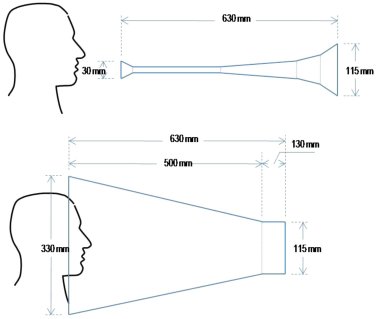Worth a Thousand Words
 If you are a fan of the World Cup, you are familiar with the ear-splitting sound of the vuvuzela. Besides being hard on the ears, this South African horn is also the topic of a paper published today, and is our featured image of the week.
If you are a fan of the World Cup, you are familiar with the ear-splitting sound of the vuvuzela. Besides being hard on the ears, this South African horn is also the topic of a paper published today, and is our featured image of the week.
The paper, Propagation of Respiratory Aerosols by the Vuvuzela, investigates whether this instrument could aide in the spread of airborne disease. Figure 1 of the manuscript (shown above) is an illustration of the setup of the vuvuzela and shouting experiments.
From the abstract:
Vuvuzelas, the plastic blowing horns used by sports fans, recently achieved international recognition during the FIFA World Cup soccer tournament in South Africa. We hypothesised that vuvuzelas might facilitate the generation and dissemination of respiratory aerosols. To investigate the quantity and size of aerosols emitted when the instrument is played, eight healthy volunteers were asked to blow a vuvuzela. For each individual the concentration of particles in expelled air was measured using a six channel laser particle counter and the duration of blowing and velocity of air leaving the vuvuzela were recorded. To allow comparison with other activities undertaken at sports events each individual was also asked to shout and the measurements were repeated while using a paper cone to confine the exhaled air. Triplicate measurements were taken for each individual. The mean peak particle counts were 658×103 per litre for the vuvuzela and 3.7×103 per litre for shouting, representing a mean log10 difference of 2.20 (95% CI: 2.03,2.36; p<0.001). The majority (>97%) of particles captured from either the vuvuzela or shouting were between 0.5 and 5 microns in diameter. Mean peak airflows recorded for the vuvuzela and shouting were 6.1 and 1.8 litres per second respectively. We conclude that plastic blowing horns (vuvuzelas) have the capacity to propel extremely large numbers of aerosols into the atmosphere of a size able to penetrate the lower lung. Some respiratory pathogens are spread via contaminated aerosols emitted by infected persons. Further investigation is required to assess the potential of the vuvuzela to contribute to the transmission of aerosol borne diseases. We recommend, as a precautionary measure, that people with respiratory infections should be advised not to blow their vuvuzela in enclosed spaces and where there is a risk of infecting others.
